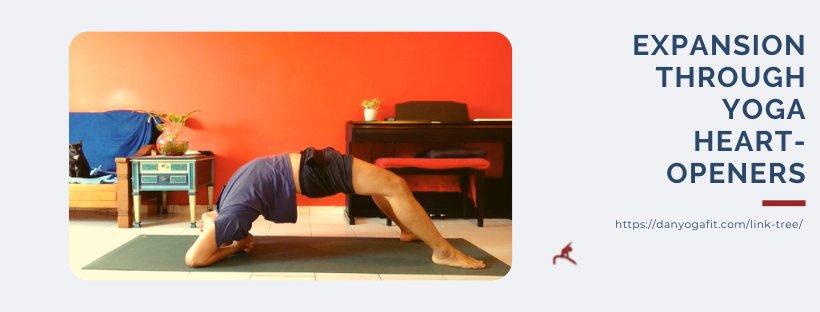When we seek to expand ourselves, it’s not just our mind and emotions that need to expand, but also our bodies. We learnt in a previous post that a slouched position is a position of stress, a posture of fear even.
And sometimes, we don’t move towards expansion / transformation / manifestation because part of us is fearful or stressed. Moving forward, away from safe spaces, can be frightening, stressful event.
However, opening up our front body, especially our heart space, sometimes helps us to embrace the capacity of change and expansion. Before you move on to the yoga poses illustrated in this post, however, take a read of the following blog posts on yoga heart-openers:
- Some thoughts on yoga backbends
- Brighten up with yoga (1)
- Brighten up with yoga (2)
- Fix your lethargy with these yoga poses
- Four yoga heart-openers to help you expand
The first and last on the list may be most helpful to you before you proceed. Also, if you have any low back issues, please be very cautious and seek the advice of your medical practitioner before you proceed.
The next four yoga movements / poses may help you open up your heart and embrace change and expansion.

Salabhasana (Locust Pose).
Salabhasana takes back and abdominal strength, which means your heart / chest space opens up (when you flex one side of the body, the opposite side usually opens up / stretches).
Rather than focusing on how high you can lift up your chest and legs, think of lengthening your spine (which includes your neck!) and distributing the work evenly through your upper, middle, and lower back. Lengthen your tailbone towards your heels.
If you find this yoga pose challenging, work on first lifting your chest up only, then take a break, then lift the legs up only. Hold for five breaths.
Ustrasana (Camel Pose).
Unlike the yoga asana previously explored, this heart-opener is a little more intense. So it’s worth taking your time to do it safely.
Watchpoints:
- Avoid just dropping into the yoga pose, with the brunt of the backbend taking place in your neck and low back. Rather, lengthen your torso and spine gently to arch back into the pose.
- Lengthen your tailbone towards the ground / your knees.
- Look forward if you feel constriction in the neck
- Stop what you’re doing and take child’s pose if there is any sharp pain in the low back.
The video below is for a chair-supported ustrasana.
The following video is for ustrasana and a few variations to expand the heart-space.
Urdhva Dhanurasana (Upward Bow).
Also known as Chakrasana (Wheel Pose), this yoga pose should not be confused with the backward tumble (chakrasana) in the Ashtanga Vinyasa series. This yoga asana an intense backbend which challenges us all.
Keep in mind that the bend takes place at the upper back (which is more mobile) and not the lower back (which is meant to be stable). ALWAYS lengthen the tailbone downward (backward tilt of pelvis, as in cat pose).
Please also let go of misconceptions that the shape needs to be ‘perfect’. There are many benefits to the pose, no matter how it looks, so long as we practise safely, maintain our strong alignment, and leaves us feeling good.
Dwipada Viparita Dandasana (Upward Facing Two-Foot Staff Pose).
This is the most intense backbend / yoga heart-opener of the four. Please be very mindful of your neck, your breathing and any constraints on the low back as you practise.
The video below shows the entry from Urdhva Dhanurasana, so attempt this Dwipada Viparita Dandasana only if you can comfortably do Urdhva Dhanurasana.
Please do email me if you have any questions! And please avoid attempting this yoga posture if you are beginning with your yoga journey at this juncture.
Bonus Yoga Pose: Purvottanasana (Upward Plank Pose).

This yoga pose is easier than the last three asana above. However, the work takes place in the upper back, so if your butt sinks or the upper back doesn’t do its work, you may feel stress and compression on your wrists.

Join my Facebook group with full class sequences and talks on yoga & mindfulness!
